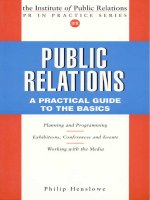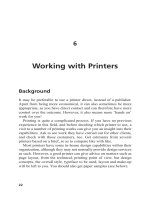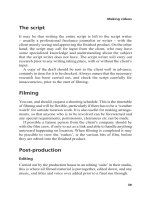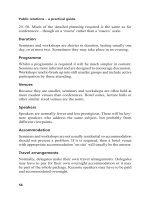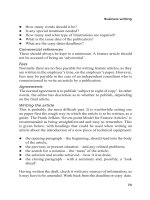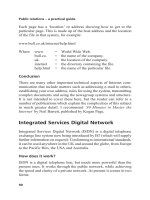Public relations a practical guide to the basics_9 pptx
Bạn đang xem bản rút gọn của tài liệu. Xem và tải ngay bản đầy đủ của tài liệu tại đây (318.9 KB, 17 trang )
Appendix 4
124
Appendix 4
Employment Law
This is a very complex area and one covered by a considerable amount of legislation.
Basically, there are two types of employment relationship: contracts of service, and
contracts for services.
Contracts of service
A contract of service, also known as a contract of employment, is the legal relationship
between an employer and employee, ie the normal contract for an employed person.
It is used where the employer exercises a large degree of control continuously over
an employee on a long-term basis.
Employers’ liability
Under the terms of this type of contract the employer may be made liable under the
laws for Torts, or wrong doings committed by his or her employees during the course
of their employment. The law in this case also imposes a high standard of care on an
employer with regard to health and safety of his or her employees, both under statute
and common law.
Economic implications
Employees income tax is deducted from their wages under the PAYE Scheme
(Schedule E). Likewise, under the Social Security Act 1975 both employer and
employee must contribute to the payment of Class 1 National Insurance contributions.
An employee is then entitled to claim all available welfare benefits, eg unemployment,
sickness, industrial injury etc.
319 app 4.p65 13/06/00, 13:00124
125
Appendix 4
Other statutory rights
The Employment Protection (Consolidation) Act of 1978 conferred a number of
rights and benefits on an employed person, eg: the right to written notice of details
of employment (the contract of employment) within the first 13 weeks of employment,
the right to receive certain minimum periods of notice of dismissal, the right to
redundancy payment in appropriate circumstances, to protection against unfair
dismissal, to be a member of a trade union and engage in union activities, and the
right to protection against an employers insolvency.
Contracts for services
Used by self-employed people, contracts for services concern the carrying out of a
specific task, or tasks, usually for a limited period or intermittently. They may not
have as much control over standards of performance as a contract of service, although
the terms of the contract may cover this. The task of distinguishing between the two
types of contract has been left to the courts to decide in cases where there are doubts
or problems. Any contract should tie in with IPR and/or PRCA codes of conduct.
Employers’ liabilities
As a general rule, the employer is not liable for Torts committed by independent
contractors during the course of their employment and has a lesser standard of care
towards the contractor with regard to health and safety, both under common law and
statute law.
Economic implications
A self-employed person is responsible for his or her own tax liability and pays tax
under Schedule D on a preceding year basis. Under the Social Security Act 1975 the
self-employed person is responsible for payment of lower rate Class 2 contributions.
The self-employed person has no entitlement to certain welfare benefits, eg
unemployment or industrial injury, but may claim others, eg sickness benefit.
Other statutory rights
The majority of the statutory rights under the Employment Protection (Consolidation)
Act 1978 are not available for self-employed persons.
319 app 4.p65 13/06/00, 13:00125
Appendix 5
126
Appendix 5
Checklist of Public Relations
Assistance on the
Exhibition Stand
Exhibitions: Record all visitors to the stand
319 app 5.p65 13/06/00, 13:01126
127
Appendix 5
Much of this information will also apply when running your own stand.
Before the event
l Contact the exhibition press office get all the detail you can. Who is opening
the exhibition, when, where? Try and get the VIP and party on to your stand.
l Ensure you have a good selection of promotional gifts, that there are enough to
last, and that they are appropriate to the event.
During the event
l Get your companys VIPs on the stand on press/preview day. Include the board
members, or at least the chairman and CEO.
l Organize a private press reception on your stand.
l Check out the media opportunities. Find out what coverage is expected. Which
TV networks and radio stations are covering the event?
l Record all visitors to the stand have a visitors book or equivalent.
l Check on any press receptions planned during the event. Where and when will
they be held, and who will be there?
l Foster media interest. Find out about appropriate programmes/publications etc
for the future.
Afterwards
l The wash up: It is most important to evaluate all the tangible results and
look for any lessons learnt. What did the event achieve? Was it cost effective?
l Follow-up action: All visits and enquiries at your stand from potential clients/
customers and from the media must be followed up with a letter.
l Writeups: Freelance journalists may want to write up the exhibition and your
stand in particular, in feature articles after the event.
319 app 5.p65 13/06/00, 13:01127
Appendix 6
128
Appendix 6
Event and
Conference Planning
Conference travel
Rail concessionary rates for delegates
Some railway operating companies offer concessionary conference rates on rail
tickets for delegates, depending on the circumstances, the size, venue etc of the
conference. Many larger mainline stations now have business travel centres where
such enquiries (and sometimes bookings) may be made. They can also be made
directly on application to the train operator concerned.
Some numbers to ring are:
l GNER: 01904 523 615;
l SW Trains: 0171 922 9713;
l Scotrail: 0141 335 3215;
l SE Railways: 0171 626 1671;
l Great Eastern Railway: 0171 922 9157;
l Regional Railways: 01743 458099;
l Virgin Trains: 0171 922 6409.
319 app 6.p65 13/06/00, 13:01128
129
Appendix 7
Appendix 7
Planning Guidelines – Events
Below are some bullet points for use when planning events generally which should
be helpful to you when planning your own.
Before planning any event, first ask yourself the following questions:
l Is it newsworthy?
l Will it show the subject off well?
l Will it have the right atmosphere?
l Is it relevant?
l Is it appropriate?
If the answer to each of these is yes then you can begin. In general terms, for
planning purposes you need to:
l Get the budget allocated.
l Appoint a small planning group probably no more than four people.
l Select the venue.
l Draw up an outline programme of events.
l Produce a timetable and detailed programme.
l Circulate these to all concerned in good time to allow for changes.
l Check the details.
l Have a wet weather programme (if applicable).
NB All work must be within budget limits.
319 app 7.p65 13/06/00, 13:02129
Appendix 8
130
Appendix 8
Planning Guidelines –
Conferences
When planning a conference, as with events generally, you should first ask yourself
the following questions:
l Why have it? What will be achieved by staging it?
l Who is the keynote speaker? Is there a personality attending?
l Who are the target audiences? Who is it for?
l Is it a prestige event? Is it overseas or UK based? Is an exhibition
included?
l What is the venue? Hotel, stately home or conference centre?
l Will it be expensive? How much is reasonable?
l How long is it to last? A week, a weekend or only a day?
l When is it to be staged? Will it clash with other major events?
A Checklist for conference planning
Venue Check availability beforehand. Dont forget time
needed for rehearsals, mounting/dismantling the
stand etc.
Facilities Sound systems, A/V systems, TV and radio facili-
ties. Have backup available. Rehearse with all
equipment.
319 app 8.p65 13/06/00, 13:03130
131
Appendix 8
Book caterers Liaise with whoever is in charge. Plan menus.
Programme of events Circulate widely.
Brief Chair(s) Also keynote speakers etc. Have copies of speeches
available.
Audio-visual material Check on copyright and equipment.
Train & rehearse Presenters, speakers. Rehearse speeches etc.
Conference packs Publications, folders, presentation transcripts,
photographs.
Invitation and Compile a list in good time. Design, mail
mailing lists and follow up.
Programme Send map of venue and general venue information to
delegates.
Accommodation Check on bookings/dietary requirements.
Travel arrangements Entertainment/day trips/discounted arrangements for
rail/airlines.
Mounting Check on set design for stage, room layout, seating
etc.
Translation service May be needed.
Insurance and security Liaise with venue organization.
Reception area Registration of delegates, badges, information packs,
timetable, delegate list, pens, pads.
Hire of equipment Office equipment, fax machines, phones.
The above are some of the main points to remember, but the list is by no means
exhaustive. There may well be other points particular to the event being
planned that you should include.
Always make a checklist, otherwise you may forget something vital!
319 app 8.p65 13/06/00, 13:03131
Appendix 9
132
Appendix 9
VIP Visits
VIPs: Transport & Security
319 app 9.p65 13/06/00, 13:03132
133
Appendix 9
General planning
Beforehand you need to know:
l the reason for the visit and its duration;
l the date and approximate timings for the visit;
l the locations to be visited (including your own);
l travel involved between locations, and timings;
l what security restrictions, if any, are involved;
l mode(s) of transport involved.
Having got the above general information, you can then plan the detailed timetable
for your part of the visit within the overall programme. You need to know the
following:
l How many will be in the party?
l What transport arrangements will be needed?
l Who they are to meet, where and when?
l When will they be received and by whom? What is the protocol?
l What presentations, if any, to be made on arrival?
l What location(s) are to be visited?
l What opportunities will there be to meet local people?
l Will there be walkabout opportunities?
l What special arrangements needs to be made for the media?
l Are VIP retiring room facilities required?
l Are refreshments to be offered? (Are there any special dietary requirements?)
l Are there any special requirements or requests from the VIP?
319 app 9.p65 13/06/00, 13:03133
Appendix 10
134
Appendix 10
Royal Visits
Royal visits are comparatively rare but require meticulous planning and attention to
detail. This type of visit varies enormously, depending on the category and status of
the Royal concerned, and there are certain procedures to be followed.
Who should be invited?
You need to know which Royal personage would be most appropriate for your
particular organization. Each one has their own special interests and support different
charities and good causes. The offices of the Lord Lieutenancy for the county in
which the visit is taking place can advise you on this and, more importantly, if and
when he or she is likely to be available. (They will also advise you about visiting
VIPs from overseas). The offices will tell you to whom you should write in the first
instance. Note that all correspondence relating to the visit should be copied to the
Lieutenancy.
Time tabling
1. About six months prior to the proposed visit, write to the Private Secretary of
the VIP concerned, setting out your request. If your invitation is accepted and
put in the diary then you can draw up your draft outline programme with
timings. You can probably make certain arrangements in advance (who will be
involved, when and where).
2. Submit a draft programme to the Lieutenancy for their approval. This is usually
required several months in advance.
319 app 10.p65 13/06/00, 13:04134
135
Appendix 10
3. Amend your draft programme as necessary. Resubmit for approval.
4. Finalize the programme and send it to the Lieutenancy. Allow for last minute
changes to be made.
5. Submit lists of names of persons to be presented this is for security vetting
and for briefing purposes.
6. Liaise with police over final security arrangements.
7. Who is coming? Get details of the party accompanying the visitor (the Lord
Lieutenant, ADC, Lady-in-waiting, Lord Mayor etc).
8. Presentations etc. Who is to present a bouquet (if appropriate)? Has it been
ordered? Are there any special VIP/Royal preferences (or allergies)?
9. Alert the media if they are not already aware. Inform the COI and prepare news
releases for distribution. (Remember to coordinate this through the Lieutenancy).
The day before
Get confirmation of the time of arrival at your location, plus other details such as
the mode of travel of the Royal party, size of police escort, etc. The police will
usually sort things out for you.
On the day – security
There is usually a special Royal protection party, provided from the local police
force, in addition to the bodyguard from the Royal protection squad. They can give
you up-to-the-minute reports on the Royal progress and can often smooth the path
with any recalcitrant media.
319 app 10.p65 13/06/00, 13:04135
Appendix 11
136
Appendix 11
Written Reports
Tell what you are going to tell them, tell them and then tell them what you have
told them.
A written report must always be:
l Acceptable that is to say, well presented.
l Easily understood use short sentences and paragraphs. Avoid jargon or at
least explain it.
l Objective use the third person never personalise a report.
l Factual but stylish but see house styles/on page 69.
l Logical in the flow where there are different kinds of information being
presented make sure that they can all be easily and quickly located.
l Brief be succinct use short sentences and paragraphs.
A summary at the start can be helpful. You should also include a conclusion with
any recommendations.
Layout
When writing reports, it is useful to have a standard reference numbering system for
all paragraphs and sub-paragraphs for ease of quick reference. Thus:
1. Paragraph
1.1 sub-paragraph
1.1.1 sub-sub-paragraph and so on.
(But see also house styles on page 69. Always number the pages, and for statistics,
costings etc use annex with their separate appendices if necessary.
319 app 11.p65 13/06/00, 13:05136
137
The roles of public relations
Appendix 12
Agenda Format
Agenda
For
Committee Meeting
to be held at
[wherever] at [time] on [date].
(always specify time, date & venue)
Apologies for absence.
These can be either in writing or given verbally.
1. Minutes of the previous meeting.
Indicate here if they were previously circulated (specify date), or if they are to
be tabled at the meeting.
2. Matters arising [and not dealt with elsewhere on the agenda].
3. Topic(s).
The items to be discussed or dealt with at the meeting. They may be either
tabled, spoken to or attached to the agenda.
4. Any other business.
Any items not already on the agenda but which need to be dealt with or may
be called for at the start by the chairman.
5. Date, time and venue of next meeting.
Agenda items should be numbered for ease of reference to papers/reports etc.
319 app 12.p65 13/06/00, 13:06137
Appendix 13
138
Appendix 13
Example of Layout for
an Internal Paper
Agenda Item
Name of Committee
Short Title of Paper
Date of meeting
Full title of paper
1. Summary
1.1. This section of the report should give a brief introduction to the topic and
highlight the main reasons for it, any problems or the current situation
generally, depending on the circumstances.
1.2. It should also give a précis of the arguments set out later in the report,
and may recommend a course (or courses) of action to be taken, mention
any cost implications and generally set the scene.
1.2 Present position
2.1 Here the background is given to the present position as succinctly as
possible. It should include details of the causes that have given rise to the
present position.
319 app 13.p65 13/06/00, 13:07138
139
Appendix 13
3. Possible solutions
3.1. It is often best to put forward several different possible solutions, or courses
of action, that could be taken, with the arguments for and against each,
together with an outline of costs involved.
3.2. Each course of action should have a headline followed by a brief
explanatory paragraph.
4. Preferred solution
The recommended course of action to be taken.
5. Costings
The financial costs, any benefits arising and other details of relevant financial
information. This will be helpful to any decision making. Any detailed breakdowns
should be given in an appendix to the report.
6. Conclusion
6.1. A summary of the action required, and the preferred solution.
6.2. Request for any approvals and any action to be taken.
Author of the report
Job title
Date
319 app 13.p65 13/06/00, 13:07139
Appendix 14
140
Appendix 14
Example of Layout
for Minutes
Action
by
Present
The names, appointments and titles of those attending.
Apologies
Names etc of all those who have notified their absence.
1. Minutes of the last meeting.
These should be signed and dated as a true record by the Chair. All heading thereafter
to be numbered sequentially.*
2. Matters arising
2.1. Unfinished business.
Any business recorded in the minutes that has not been dealt with, or is not on
the agenda.
3. Agenda items
The main part of any minutes. The title of each item discussed should be the same
as the relevant agenda item.
319 app 14.p65 13/06/00, 13:07140

